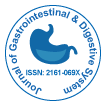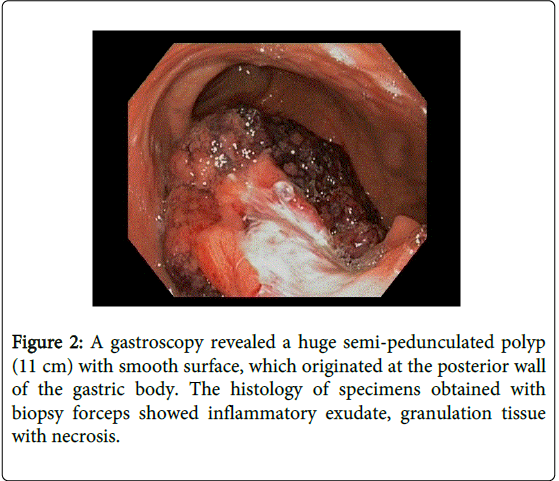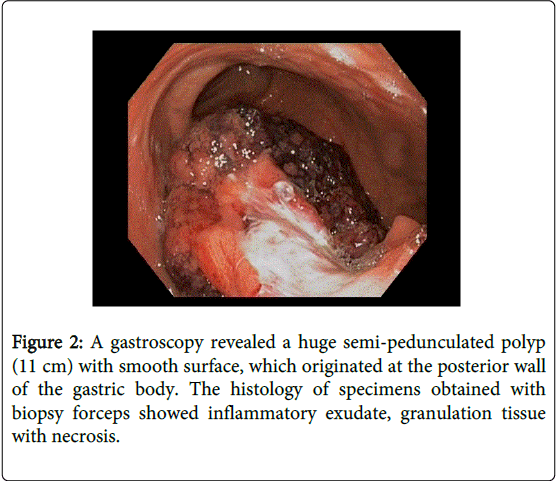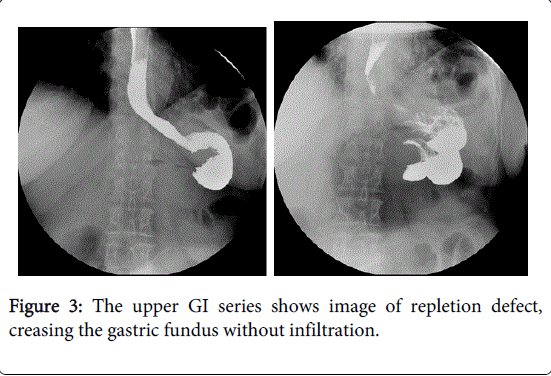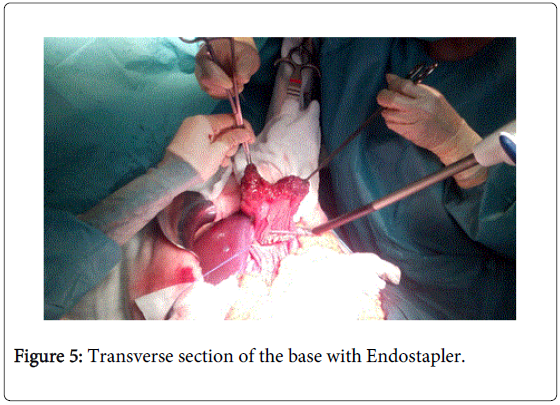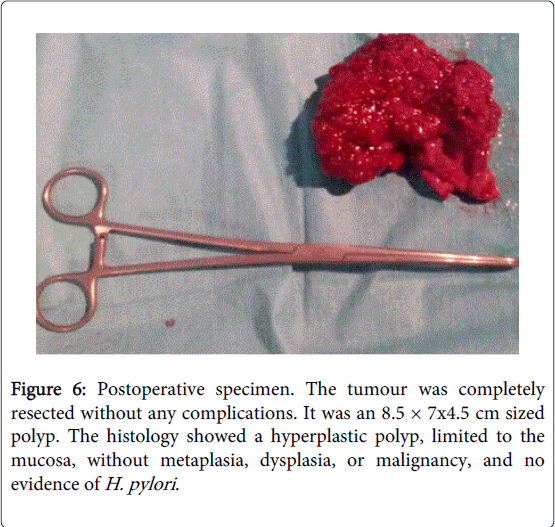Case Report Open Access
Giant Gastric Polyp, A Rare Cause Of Gastric Outlet Obstruction
Lidia Cristobal Poch, María Heras Garceau, Carolina González-Gómez, Juan Antonio González and Ramón Cantero*General and Digestive System Surgery Service “La Paz University Hospital”, Paseo de la Castellana 261, 28048. Madrid, Spain
- *Corresponding Author:
- Ramón Cantero MD. PhD
EBSQc, Associate Professor.
La Paz University Hospital
Paseo de la Castellana 261
28048, Madrid, Spain
Tel: 0034-696464464
E-mail: ramon.cantero@salud.madrid.org
Received date: July 20, 2015 Accepted date: August 11, 2015 Published date: August 17, 2015
Citation:Poch LC, Garceau MH, Gómez CG, González JA, Cantero R (2015) Giant Gastric Polyp, A Rare Cause Of Gastric Outlet Obstruction . J Gastrointest Dig Syst 5: 321. doi:10.4172/2161-069X.1000321
Copyright: ©2015 Poch LC, et al. This is an open-access article distributed under the terms of the Creative Commons Attribution License; which permits unrestricted use; distribution; and reproduction in any medium; provided the original author and source are credited
Visit for more related articles at Journal of Gastrointestinal & Digestive System
Abstract
Gastric polyps are often an incidental finding on upper gastrointestinal endoscopy. Hyperplastic polyps are the most commonly encountered gastric polyps (75%). Most of gastric polyps are asymptomatic but they may present with occult bleed, obstruction or abdominal pain. We report a case of an 80-year-old woman who presented with a benign gastric polyp causing an intermittent gastric outlet obstruction, who was successfully treated with resection.
Abstract
Gastric polyps are often an incidental finding on upper gastrointestinal endoscopy. Hyperplastic polyps are the most commonly encountered gastric polyps (75%). Most of gastric polyps are asymptomatic but they may present with occult bleed, obstruction or abdominal pain. We report a case of an 80-year-old woman who presented with a benign gastric polyp causing an intermittent gastric outlet obstruction, who was successfully treated with resection.
Keywords
Gastric polyp; Gastric outlet
Introduction
Gastric polyps most frequently originate in the mucosa, but include a broad spectrum of pathological conditions, that may be even submucosal or extrinsic [1]. Histologically, they can be classified as hyperplastic polyps, adenomatous polyps, fundic gland polyps and inflammatory polyps [2]. Gastric hyperplastic polyps are associated with H pylori gastritis, while fundic gland polyps are with proton pump inhibitor use [3].
Gastric polyps are a rare entity, with an incidence of 3-5% in Japan [1]. Most patients are asymptomatic. Symptomatic presentation can vary from occult bleeding to complete gastric outlet obstruction. Most polyps have no risk of cancer, but there are certain subsets of polyps with malignant potential.
We describe a case of intermittent gastric outlet obstruction by a giant hyperplastic polyp and its subsequent management.
Case Report
An 80-year-old independent woman, with a background of intolerance to aspirin, asthma, anxiety, diverticular disease and chronic venous insufficiency, presented with a combination of severe abdominal pain and intermittent vomiting of partially digested food after meals.
Four months before admission she started with food intolerance and gradual weight loss (5 Kg in three months).
At admission, laboratory tests revealed hyperamylasemia, and she was diagnosed with a mild acute pancreatitis.
CT-scan showed thickness of the antral gastric wall with atypical gastric morphology.
Upper endoscopy revealed a gastric volvulus, solved by the endoscopist, and an ulcerated mass. Edema and thickness of the wall down to the second duodenal portion. Biopsy of the mass didn´t show malignancy (Figures 1-3).
Due to the suspicion of malignant tumour causing a gastric outlet obstruction, poor oral intake and without histological confirmation, surgical treatment was recommended. A transverse gastrostomy exposed a 10 cm pedunculated polyp, arising from the posterior wall of gastric fundus. This polyp was seen prolapsing into the duodenum, causing intermittent gastric outlet obstruction. The polyp was excised with Endostapler and sent for pathology (Figures 4-6). There were no postoperative complications.
Discussion
Hyperplastic or regenerative polyps are the most common kind (75-90%) [2]. Most are an incidental finding on upper endoscopy. Symptomatic presentations can range from an ulcerated polyp leading to anaemia and occult bleed to complete gastric outlet obstruction. Frequency of malignant transformation is 1.5-3% of hiperplastic polyps [2]. Polyps that are greater than 1 cm have a higher risk of neoplasia [2].
The treatment of gastric polyps is excision. In some studies, there have been reports od co-ex of H. pylori and hyperplastic polyps. Eradication of H. pylori resulted in regression of the existing polyps and prevented new polyps to develop. Surgical treatment is recommended in polyps greater than 2 cm, sessile polyps, and failure of endoscopic treatment.
Incidence of gastric outlet obstruction due to polyps is unknown, with only few cases reported in literature [3-8]. Differential diagnose should be made with peptic ulcer, gastric or pancreatic carcinoma, duodenal polyp, pancreatitis and Crohn disease, among others.
Conclusions
Gastric polyps are a rare entity, often found incidentally on upper gastrointestinal endoscopy. The majority of gastric polyps are asymptomatic but they often present with occult GI bleeding or partial gastric outlet obstruction. A gastrostomy was an effective choice of treatment, considering the polyp size, and potential for malignancy, as opposed to an endoscopic approach.
References
- Ming S (1992) Epitthelial polyps of the stomach. In: Ming S, Goldman H,eds.Pathology of the Gastrointestinal Tract. Philadelphia: WB Saunders 547-69.
- Palacios Salas F, Frisancho Velarde O, Palomino Portilla E (2003) [Gastric polyps and histological changes in surrounding mucosa]. Rev Gastroenterol Peru 23: 245-253.
- Debongnie JC (1999) Gastric polyps. Acta Gastroenterol Belg 62: 187-189.
- Ming SC (1977) The classification and significance of gastric polyps. Monogr Pathol : 149-175.
- Jung JT (2013) Gastric polyps and protruding type gastric cancer. Clin Endosc 46: 243-247.
- Kang HM, Oh TH, Seo JY, Joen TJ, Seo DD, et al. (2011) [Clinical factors predicting for neoplastic transformation of gastric hyperplastic polyps]. Korean J Gastroenterol 58: 184-189.
- Espejo Romero LH, Navarrete Siancas J (2004) [Gastric epithelial polyps (part two)]. Rev Gastroenterol Peru 24: 50-74.
- Castano LR, Ruiz VMH, Jaramillo P, Sanín FE, Botero ML, et al. (2005) Gastric Polyps: epidemiological aspects and its relation with proton pump inhibitors. Rev Col Gastroenterol 20: 48-59.
Relevant Topics
- Constipation
- Digestive Enzymes
- Endoscopy
- Epigastric Pain
- Gall Bladder
- Gastric Cancer
- Gastrointestinal Bleeding
- Gastrointestinal Hormones
- Gastrointestinal Infections
- Gastrointestinal Inflammation
- Gastrointestinal Pathology
- Gastrointestinal Pharmacology
- Gastrointestinal Radiology
- Gastrointestinal Surgery
- Gastrointestinal Tuberculosis
- GIST Sarcoma
- Intestinal Blockage
- Pancreas
- Salivary Glands
- Stomach Bloating
- Stomach Cramps
- Stomach Disorders
- Stomach Ulcer
Recommended Journals
Article Tools
Article Usage
- Total views: 16666
- [From(publication date):
August-2015 - Jul 06, 2025] - Breakdown by view type
- HTML page views : 12056
- PDF downloads : 4610
